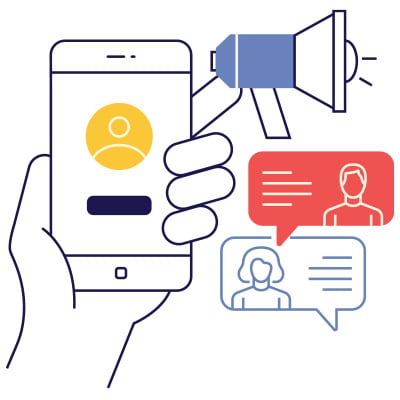
Use both hands
I use my hands to help match prospects and clients with appropriate insurance products. Each of our hands has a different role and function. I ask clients to imagine that their right hand functions as an emergency fund. If someone dies, is diagnosed with a critical illness or has an accident that causes permanent disability, the right hand provides cash that can be a substitute for income, or income replacement, to pay for living expenses such as installments, children’s school fees and so on. Meanwhile, I tell them to imagine that their left hand is functioning to pay for treatment while being hospitalized, what we call health insurance. Everyone has different needs — some only need the right hand or the left hand, and some need both. By explaining insurance in this way, prospects or clients find it easier to identify the coverage they need.
—Oktaviani Lidya Luntungan, Manado, Indonesia, four-year MDRT member
Authentic social media
Relevance is key when it comes to social media. First, decide what your target audience looks like, then dive deeper to think of what they would want to see or read. Think about your own stories and how you can make these experiences relevant for them. Rather than finding a magical formula from someone else, social media is something you must experiment with to find your voice over time. Your unique and authentic voice is what they want. You cannot engineer that.
—Candice Ong, Singapore, five-year MDRT member
7 buying signals
Sometimes clients have questions about your proposal that make it sound like they are reluctant, but these questions actually are buying signals. If we can answer their questions properly, the client will be willing to buy. Here are a few examples of buying signals:
- Will the insurance premium change every year?
- If X happens, will I get compensated?
- Can the insurance company pay the hospital directly?
- What do I do with my existing policy?
- How long do I need to wait to get compensated?
- What’s the difference between your company and others?
- If someday you leave your company, what will happen to my policy?
If you hear your potential clients asking questions like these, don’t worry. You should be happy because they are telling you what they really are thinking. If you can answer those questions to their satisfaction, you can change the challenge to opportunity and get the contract signed.
—Kwok Suet Ying, Hong Kong, China, 14-year MDRT member
Humility broth
I think a big risk advisors have is that our passion for financial services can make us believe we have the right solution for everyone, and that might not be the case. So, you must have a little bit of what I call “humility broth” in the morning to understand that you’re not for everyone. My standard line is “I’m an advisor, not a convincer.” Put responsibility on the clients and say, “What do you want to do?” as opposed to telling them what to do. “What do you want to do? What’s important to you? What’s important for your family?” Then my job is to find options for them, explain them, make sure they understand them, and then, if possible, we implement. By asking the client what they want to do, they buy in faster. They feel heard, and the rest just happens.
—Elke Rubach, LL.M, CLU, Toronto, Ontario, Canada, six-year MDRT member
Motivation is an inside job
MDRT membership provides an environment in which your life can change, but motivation is an inside job. It’s not something that comes from the outside. You can be inspired, and MDRT does a terrific job with that. You can see how your colleagues do well and the impediments they had to overcome. But in the end, it is a matter of motivating yourself by being exposed to the environment where great ideas can be shared, and perspective can be gained. My belief is the people in our business who aren’t MDRT members or don’t aspire to membership are in a completely different business.
—Brian H. Ashe, CLU, Palm Beach Gardens, Florida, USA, 52-year MDRT member and 2000 MDRT President
I love working a four-day week. It gives my wife and me the space to think, the opportunity to talk about the business and, most importantly, the freedom to relax and rejuvenate mind and body. We spend more time with the family. We even get to spend more time with my mother-in-law. We’ve broken it into working two days, with Wednesday off, and then working another two days. That gives us the energy to totally focus on the business and on the clients. We do work a little bit longer on those days, but we are totally focused on what we want to achieve with the energy to do so. We’ve been doing this since 2018, and if you base it on a 40-week working year, we’ve now gained about 200 extra days of free time to do whatever we enjoy. If you compound that over 10 years, we’ve gained an extra year of our life being off of work, but we’re still able to focus on work.
—Jeremy Mark Wellington, Dip PFS, Dip CII, Truro, England, UK, 12-year MDRT member
Establish a productive routine
Every hour of your day must be productive. The structure is critical, and it starts as soon as you wake up. After grabbing a bite, I’m on the phone with my clients, prospects or teammates. I may give several daily presentations, and if a meeting with a prospect gets canceled, I find other people to talk to. We don’t have to discuss business; the interaction is a win. What’s important is that I relate to another person.
When I started, I made it a point to add value to one person daily. Whether helping them budget their funds or trading stories and life learnings, it is important to nurture relationships. When the time comes for them to avail of insurance, I’ll be top of mind. It might not be immediate, but my efforts have been effective in helping me hit my targets and achieve my goals.
—Marvin James Inciong Revilla, Manila, Philippines, five-year MDRT member

Reframing referrals
I used to be reluctant to ask for referrals. I would talk myself out of asking because of nervousness or thinking I had not earned the right to ask for one yet. I had to better understand why a client would want to make a referral. Is it for them or for me? I attended a phenomenal seminar discussing the psychology of referrals and the behavioral aspect of clients being asked. Clients give referrals because they enjoy being a center of influence and the social connections it brings, or they have someone else they care about. Least important is that their advisor does more business. So, the referral talk track I am comfortable with is more about how they might benefit from a referral.
—Jakob Bower, Muscatine, Iowa, USA, two-year MDRT member
Show your proof
We share our claim success stories on our Facebook page and use the image of the checks, excluding the clients’ details, along with a little background to the condition, sum insured, client age, etc. We also have our own large company check, which we can fill out using a whiteboard marker and hold this up in our photos that we post on social media. We get good engagement with these posts. It has become a claims library for us to refer to and helps us reassure new or existing clients who may not believe insurers pay claims or may doubt our efforts to help clients at claim time.
—Peter Jason Byrne, Coorparoo, Queensland, Australia, 15-year MDRT member
A better way to finish
Don’t finish your presentation to prospects and clients by asking, “Do you have any questions?” They’ll feel uncomfortable because you’re making them feel like they should have questions. Instead say, “What questions do you have for me?” If there are none, that’s your cue to let them know what the next steps are. But rather than telling them what to do, tell them what “most people do.” People are comfortable knowing that they’re not the only ones following your advice.
—Phil Jones, influence and persuasion expert and author of “Exactly What to Say: The Magic Words for Influence and Impact”
Survey results
If you hold client events, make sure to do a client satisfaction survey. Clients can feel satisfaction and imagine their financial future only through consultations with their advisor. Allow them to give meaning to significant events you provide and the time they spend with you. Make them confident in their relationship with you by asking if they are satisfied with your advice. This also gives you a chance to make up for what you lacked and think of what to say, how to give them advice and words of encouragement for more pleasing consultations in the future. When you build a positive relationship with your clients and underline how you are growing by filling in what is lacking, you could strengthen the relationship with your clients, and it would be easier to move on to the next step.
—Byeong Hoon Choi, MBA, Seoul, South Korea, 14-year MDRT member
